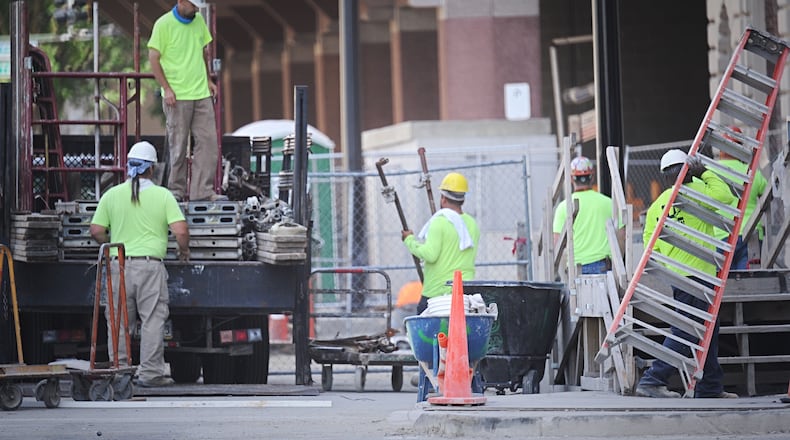“I know I’m not alone,” said Krupp, 42.
The pandemic, with its lockdowns, business failures and government-ordered closures, forced more than 1 million Ohioans out of work this spring, said Policy Matters Ohio in its annual Labor Day report.
Krupp, a Springfield resident, had worked for 15 years at Pathway School of Discovery in Dayton before being diagnosed with multiple sclerosis three years ago. A strenuous health care regimen forced her to quit that job, and she embarked on a tough job search.
Before she found her current job, she said, “I probably applied for 40 different jobs in education, just around Dayton schools, Springfield, everywhere and anywhere. And I could not get a job to save my life.”
Krupp is grateful to have a job today, but she said lower pay is forcing her to sell her home. “I have no choice.”
Outside her circle of friends who are teachers, “There are lots of people without jobs right now ... there are no jobs out there,” she said.
On Labor Day last year, the nation was starting its 19th month with a jobless rate at or below 4%.
This year, Labor Day is dramatically different, finding millions more workers unemployed due to a savage global pandemic and its effects.
Government numbers tell part of the story. The national unemployment rate in February — just before coronavirus truly sunk its claws into the United States — was 3.5%. In August, it was 8.4%, the government released Friday.
In April, Ohio had only 4.7 million jobs: fewer than at any time in the previous 30 years, Policy Matters Ohio said in its Labor Day report.
Usually it takes months for joblessness to spike in a more normal recession. With the pandemic, it took a couple of weeks.
“We’ve never seen a disintegration of the labor market so quickly,” said Rea Hederman Jr., executive director of the Economic Research Center and vice president of policy at The Buckeye Institute in Columbus.
In April, Ohio’s unemployment rate spiked at what the Policy Matters report called a “staggering” 17.3%.
By July, matters were better. The Ohio jobless rate stood at 8.9%, down from 11% in June.
But the number of workers unemployed in Ohio has increased by 262,000 from 241,000 in July 2019. The July unemployment rate last year was just 4.2%.
“When the pandemic hit, Ohioans didn’t hesitate,” said Hannah Halbert, executive director of Policy Matters Ohio. “Wherever you were at ... working people all across the state pulled together and did what they had to do to confront this.”
“We see that Ohioans are really dealing with real financial pain,” she added. “I mean, the scope of this thing is really hard to comprehend in some ways.”
In some ways, at least part of that economic devastation was self-imposed, she agreed. But that means now, government at the state and federal levels should strengthen workers and help return them to good jobs, she contends.
Policy Matters recommends robust unemployment support, along with wage and other measures. The organization calls for raising the Ohio minimum wage to $15 an hour, up from $8.70 an hour for non-tipped employees today, a 15-cent increase from 2019′s minimum.
The minimum wage has gradually seen its purchasing power eroded. Halbert said grandparents had greater purchasing muscle with their minimum wage than today’s minimum wage earners manage.
Wages have been divorced from productivity, and working people aren’t able to collectively bargain as they once could, Halbert argues.
But the organization sees longer-term concerns. 2019 saw the end of the longest economic expansion in U.S. and Ohio history.
“For working people, it didn’t get them a whole lot,” she said of the expansion.
Hederman, of the more market-focused Buckeye Institute, recommends other paths.
Ohio General Assembly last week sent a liability protection bill to Gov. Mike DeWine -- protecting businesses from lawsuits centered on COVID-19 outbreaks.
“It’s good policy because it will give people peace of mind and encourage businesses and non-profits to continue to expand,” Hederman said.
Ohio government should also continue its suspension of telehealth regulations that make it more difficult to connect with doctors and nurses online.
In July, DeWine issued an executive order allowing more types of health care practitioners to provide telehealth services, including: home health and hospice aides, private duty registered nurses and licensed practical nurses in a home health or hospice setting, dentists and others.
“We’ve seen a surge of people being able to conduct telehealth businesses because, you remember, a lot of hospitals and doctors stopped providing health care services in person,” Hederman said. “For people who were sick, who maybe had a cancer screening coming up, they are able to do some of these things online.”
He sees reason for cautious optimism. Most pessimistic projections earlier in 2020 had expected a 9% unemployment rate by year’s end, and the rate is already below that.
“We do seem to be recovering a little faster than what people had expected,” he said.
A “solid” economic recovery is underway, said Gus Faucher, chief economist for PNC Financial. But he sees challenges ahead.
“Job growth will slow over the rest of 2020 and throughout 2021 as permanent business closures increase,” Faucher said in an email.
Among the risks he sees: Congress failing to provide more fiscal stimulus, the continued spread of the virus and uncertainty surrounding the presidential election.
Ohio job losses by industry, from June 2019 to June 2020:
Leisure and hospitality: 170,800 jobs lost (30%)
Construction: 17,400 (7.7%)
Manufacturing: 44,300 (6.3%)
Trade, transportation and utilities: 65,200 (6.4%)
Information: 5,500 (7.9%)
Financial activities: 14,700 (4.8%)
Professional and business services: 83,500 (11.3%)
Health Care and social assistance: 45,200 (5.5%)
State government: 18,800 (10.6%)
Local government: 43,100 (8.2%)
Source: Ohio Department of Job and Family Services, cited by Policy Matters Ohio.
About the Author

